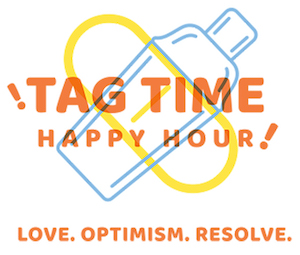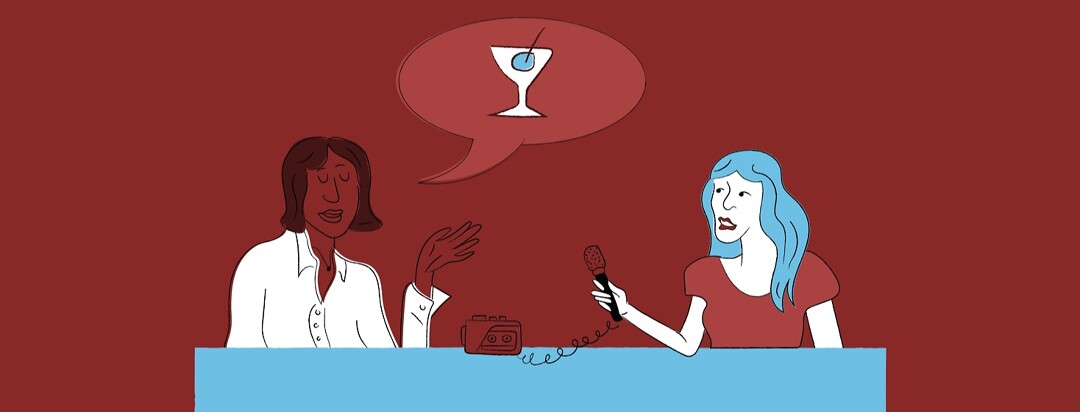Meet Kristina and TAG Time Happy Hour
Kristina's husband, Jim, was diagnosed with lung cancer in August 2020. In this conversation with LungCancer.net, Kristina talks about how her family and community rallied around Jim following his diagnosis and it inspired the #TagTimeHappyHour movement.
Meet Kristina and Jim Burke
Our connection to lung cancer began in August of 2020 when my 47 yr old husband, Jim, was diagnosed with stage IV EGFR lung cancer. With very few symptoms and being a youngish, fit, “never smoker” - this diagnosis came as a complete shock to us. Luckily, we live extremely close to an incredible hospital with nationally recognized doctors who are leading the way in medical advancements for patients with lung cancer. The confidence we have in our care team makes all the difference in how we go about our living with this diagnosis.
Biomarker testing gave us options
Once we found out it was lung cancer that had metastasized we were put in touch with a thoracic surgeon who would be performing Jim’s bronchoscopy. He explained that a biomarker test can be done at the same time where blood and tissue samples would be collected while Jim was undergoing his procedure. Of course, once we learned more about it, we did proceed with the testing. The more you know about the type of cancer and its genetic origins, the better outcome you may have because of the advancements in treating genetic mutations.
Advocate for yourself and ask for help
It’s crucial for patients to have an advocate or navigator in the healthcare system that can help patients and caregivers very early on. The diagnosis alone is overwhelming. You are balancing an onslaught of emotions while trying to stay focused on learning new information about you or your partner's disease. There are mountains of new scientific information being hurled at you, and trying to digest it all while figuring out the best path for treatment is a tremendous burden on those newly diagnosed. Becoming educated, asking your care facility for assistance, and finding forums to ask questions and speak to people who have experienced the same thing is always very helpful.
Even if you are new to, or slightly nervous about opening up to strangers online, those strangers will ultimately become your community. Making sure newly diagnosed patients are immediately offered an advocate to answer questions or talk about shared experiences, will ultimately help patients become more aware of early biomarker testing, leading to safer and possibly better outcomes for patients because of advanced lung cancer treatment.
From my perspective as Jim's wife...
The diagnosis is shocking because before you are even aware of the minor symptoms you are experiencing, the disease has already metastasized causing damage to many areas of the body including bones, liver, and brain. So just understand that the first couple of months are dark.
Allow yourself time to sit with these difficult realities and the waves of emotions that wash over you. You and your partner are both experiencing this together, but also apart. It’s just the nature of how cancer can affect deep and complex relationships. I highly recommend asking what your health care facility can do for its caregivers and patients regarding mental health support. Aside from mental health services, the hospital where we are treated for cancer also offers a variety of workshops including yoga, reiki, music, and art therapy all free to patients and caregivers alike. They have even pivoted during the pandemic to offer many of these workshops online. Remember, if you don't’ take care of yourself, you cannot take care of anyone else.
Our approach to raising a family with lung cancer
This is the one area of our lives that has not changed at all since both being diagnosed with cancer. My partner and I parent as a unified front, there is no good guy vs bad guy, there is never any “go ask your Mom,” there is no sick parent vs healthy parent. We are one unit, each with our own complexities and intricacies, but we are good at recognizing one another’s strengths and weaknesses and move in unison toward family goals.
We have been honest and open with our children. Our children are 11 and 7 years old so my husband and I first looked up ways to talk to children about a loved one being diagnosed with cancer. We then talked to them alone based on their ages and maturity levels. I think it’s best to focus on what the cancer diagnosis will look for them in their current world. We focused on what would change and what would stay the same for them. We let them ask any questions that came up. There are great books and resources to help parents in this area as well as books for kids of all ages covering the subjects of loved ones with cancer. We also check in often and let them know that we are here for them if they have questions, or just need some extra reassurance.
Again, look into what services your healthcare facility offers for families and children, our son has really connected with a social worker at our hospital that checks in with him bi-weekly. A healthy coping strategy for our family has been to engage in projects that directly impact their feelings. By engaging them in a project whether it be a fundraiser or creating something meaningful, you are forced to experience their feelings surrounding cancer, together. The less alone they are in their feelings, the better they can adjust to the realities of health changes throughout treatment.
For example a few times I had no choice but to have both of our children tag along while I went for my radiation treatment. I noticed that there was a little basket on a desk in the waiting room filled with odd-shaped folded pieces of paper. A note in front of their basket read “Take or leave a positive message” this was something easy the kids could do to feel engaged and helpful. They shared this positive message making gestures with some of their classmates and before you know it the teachers caught on and this simple act of kindness became a larger project. The next time the kids had to come with me to my radiation treatment they had a huge bag filled to the brim with adorable messages for patients and caregivers. I found out while I was back receiving treatment for breast cancer they walked around the waiting room and offered these joyous messages of hope to patients and caregivers. Smiles erupted in the waiting room and changed the whole energy of the room. In return, our children had less trepidation about me receiving treatment because they had shared experiences with me there.
The beginnings of #TagTimeHappyHour
I began to write journals on CaringBridge, this is a site that helps caregivers spread news to friends and family about a loved one’s health status. We found out that Jim’s first line of defense would be a targeted therapy, once a day pill known as Tagrisso. My hubby started taking it every night between the hours of 5-6pm, that’s happy hour so I would just refer to it as TAG (short for Tagrisso) Time Happy Hour.
After sharing such horrifying news about Jim’s stage IV lung diagnosis it felt so good to spread some joy and share good news surrounding his results after being on the Tagrisso. Everyone asked “what can we do?” and the truth is, especially during the pandemic, there wasn’t much people could do for us. So I simply told people to think of us each night during #TAGtimehappyhour and people didn’t just think of us, friends and family from all over the country were setting their alarms, making calls to us, sending texts, offering up prayers and best intentions on our behalf. Really uplifting videos and creative photos were sent to us during these hours, nearby friends even left us bottles of wine and champagne to keep the Tag Time Happy hour well, happy!
Evolution of #TagTimeHappyHour
 I could tell by people’s reaction to this, that there was really something meaningful behind this movement. The pandemic had been so crushing, and people were looking for anything to help others and share joy. My husband and I have been in the food and beverage industry for over 25 years and I thought why not ask our friends and colleagues in the business to host actual happy hours as a way to fundraise for lung cancer research.
I could tell by people’s reaction to this, that there was really something meaningful behind this movement. The pandemic had been so crushing, and people were looking for anything to help others and share joy. My husband and I have been in the food and beverage industry for over 25 years and I thought why not ask our friends and colleagues in the business to host actual happy hours as a way to fundraise for lung cancer research.
So I created a fundraiser and an Instagram page to create awareness all while trying to gain participants. I thought I’d just ask a handful of folks, but generous and gracious people in our industry are rallying behind us and we have participants in 6 different states and about 30 participants in Philly alone. While we have a few places hosting ongoing TAG Time Happy Hours, we’ve only officially had one completed happy hour and because of good and caring people, we’ve raised over $9k and still have about 25 establishments still to participate.
If people want to get involved with #TagTimeHappyHour, they can start by following our Instagram @tagtimehappyhour. The link to our story is in the bio. We also post where and when the TAG Time Happy Hours will take place.
Cheers!

Join the conversation